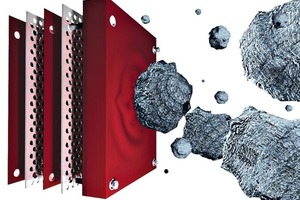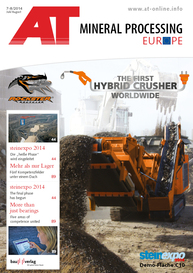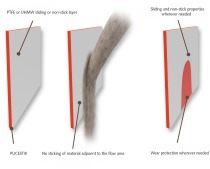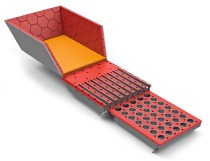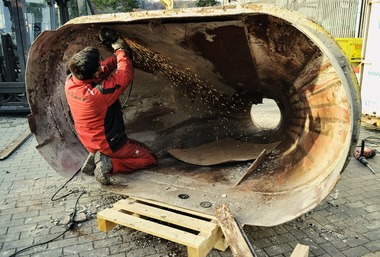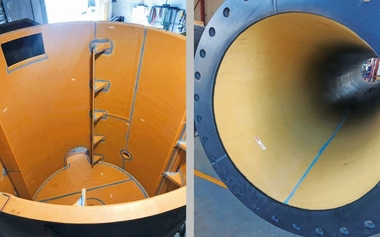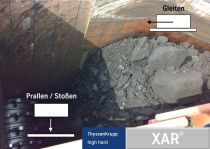Material properties in wear protection
With protection against wear and corrosion, it is possible lengthen the lifetime of machinery and equipment, save costs and prevent production outage. For optimal wear protection, the quality of the suitable wear protection material is very important. It is determined primarily based on hardness and abrasion properties.
Hardness as a measure of the wear behaviour
Hardness is the mechanical resistance of wear material to the mechanical penetration of a harder test body. Depending on the nature of the action, different types of hardness are defined. Hardness, for instance, is not only the resistance to harder bodies but also to softer bodies and bodies of the same hardness. Hardness, however, is also a measure of the wear behaviour of materials. Hard spectacle lenses scratch less, hardened cog wheels wear less. In the choice of wear protection materials, the selection of the hardness depends on the wear to which the materials are exposed. In the case of frictional wear, the base body must be harder than the counter body whereas in the case of impact wear the base body must be softer than the counter body (Fig.).
The Shore hardness is a material characteristic for elastomers and plastics and is defined in the DIN EN ISO 868 and DIN ISO 7619-1 standards. A high number denotes high hardness. In a Shore hardness tester, an additional device can be used that presses the sample to the measured with a force of 12.5 Newton at Shore-A on to the measuring bench (Table 1). Shore-A is specified for soft elastomers.
Abrasion properties
Just as important in the selection of the wear protection material are the abrasion properties. Abrasion describes the resistance of the wear protection material to frictional, impact or scratching mechanical stresses. It is determined by the surface properties of the materials involved, mainly roughness and hardness. A special role is played by abrasive wear in equipment in which media are conveyed that contain angular, hard particles. For example, frictional wear at transfer chutes, hoppers, mixer bases or impact wear at feed points, aggregate weighers and transfer points.
In industry, the abrasion strength is determined by means of methods such as grinding or sandblasting. The test is performed according to DIN ISO 4649.
Wear protection materials
The advantages of steel are the sliding properties and its availability. Disadvantages are its susceptibility to corrosion, the high noise generation during operation, the poor abrasion values and its weight. Plant components have to be replaced completely in the mid-term. Steel is welded or bolted onto plant components. It is used in impact plates, mixing tools, and mixer bases.
Advantages of ceramic are its resistance to corrosion, high wear resistance and the good sliding properties (polished). The disadvantages are its price, the high brittleness and the weight. Even in the case of limited damage, high repair costs result. The typical applications are mixer bases and walls as well as vibrofeeders.
With rubber, the advantages are the high elasticity and sound absorption. The disadvantages are incompatibility with oils and grease (mixer protection), rapid aging under the influence of air, oxygen, light and heat. As a result of aging, the material becomes brittle and breaks up, there is a possibility of liquid adsorption. Even minor damage makes replacement of the coating over large areas necessary. Rubber is used for coating at feed points, aggregate weighers, hoppers and mixer bases.
The advantages of the plastic PE are its elasticity, sound absorption and easy cutting. The disadvantages include aging, as for rubber, the necessary replacement of the coating even in the event of minor damage and low wear resistance. Typically used for coating feed points.
PUCEST® wear protection material
Optimum wear protection is provided by the reparable wear protection systems and linings made of PUCEST® developed and produced by PUCEST® protect GmbH. They impress with their long service lifetime, excellent wear and abrasion resistance, which surpasses the abrasion values of rubber, steel and other materials on PUR basis.
The material, the formula of which has been steadily optimized to meet the needs of extreme wear over many years of research, withstands mechanical loads at an abrasion of just 5.3 mm3 (65° Shore A) or 8.8 mm3 (85° Shore A) and excels also with regard to elongation and tensile strength at break (Table 2). Another big advantage is its reparability.
Complete replacement of the usually only partially worn plant components is no longer necessary thanks to the reparability with PUCEST® TIX, a smooth-on wear protection consisting of a two-component paste system on polyurethane basis specially developed for the repair of worn PUCEST® panels. It can be easily applied on a “do-it-yourself” basis in situ.
For industry, it will be increasingly important in future to reduce noise emissions. Noise is a nuisance for the workers at the workplace but also in the environment of the plant. Despite ever stricter environmental regulations, sound levels are still very high on account of the technology used. The best noise reduction is the reduction of the noise emissions where the noise is made. For this reason noise protection measures that combat the development of noise are becoming increasingly important. With lining or components made of PUCEST®, the noise level can be reduced considerably, as a result of which costs for passive noise protection measures can be saved.
//www.pucest.com" target="_blank" >www.pucest.com:www.pucest.com

